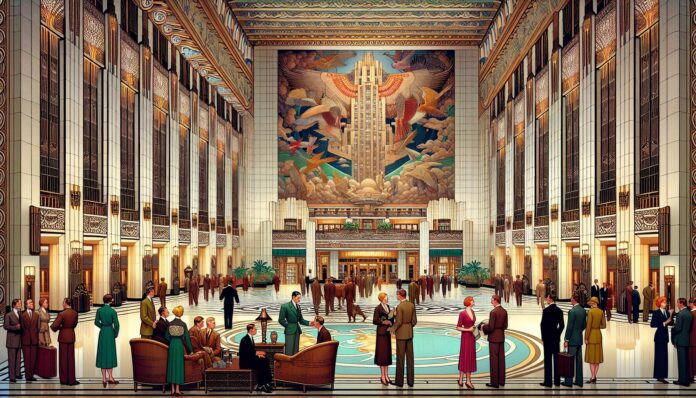Downtown Cincinnati is a treasure trove of history, and its hotels are no exception. I’ve always been fascinated by the stories these walls could tell, from whispered tales of the past to the bustling energy of the present. Each hotel has its own unique charm, offering a glimpse into the city’s rich heritage.
Walking through the heart of Cincinnati, I can’t help but feel transported back in time. The architecture alone is a sight to behold, but it’s the stories behind these historic hotels that truly capture my imagination. From grandiose lobbies to elegantly preserved rooms, they offer a special kind of magic that you just can’t find anywhere else.
So, let’s dive into the world of historic hotels in downtown Cincinnati. Trust me, it’s a journey worth taking.
The History of Downtown Cincinnati
When I first decided to delve into the history of downtown Cincinnati, I didn’t anticipate the rich tapestry of stories that would unfold before me. At the heart of it all, downtown Cincinnati isn’t just a place; it’s a living museum, each corner teeming with tales from the past.
My journey into Cincinnati’s past began on the historic streets themselves, where the architecture stands as a testament to the city’s vibrant history. The buildings in downtown Cincinnati are more than just structures; they’re monuments of the past, each telling its own story of the era it was built in. It was on these streets that I learned about Cincinnati’s role as a key player during the Industrial Revolution. Its strategic location along the Ohio River made it a bustling hub for commerce and innovation.
In the 19th century, Cincinnati was dubbed the “Queen City of the West.” This nickname wasn’t just a fancy moniker; it was a reflection of the city’s status as one of the most important and prosperous cities in the country at the time. The prosperity of Cincinnati during this era led to a boom in construction, including the grand hotels that still grace downtown to this day. These hotels were not just places to stay; they were symbols of luxury and progress, drawing visitors from all over the country.
| Date | Event |
|---|---|
| Early 1800s | Cincinnati’s rapid growth due to its strategic location along the Ohio River |
| 19th Century | Known as the “Queen City of the West” |
| Late 1800s | Boom in construction of grand hotels |
But it wasn’t just the architecture that caught my fascination; it was the stories behind these buildings. One such story is that of the underground tunnels. Originally used for transporting goods and later for beer storage during Prohibition, these tunnels are a hidden network beneath the city streets, each one carrying whispers from the past. It’s tales like these that make downtown Cincinnati not just a historical site, but a treasure trove of untold stories.
Architectural Gems: Historic Hotels
As I wandered through downtown Cincinnati, I couldn’t help but be captivated by the architectural marvels that stood as sentinel witnesses to the city’s glorious past. Among these, the historic hotels hold a special place, embodying the grandeur and spirit of an era gone by. It’s like walking through a living museum, each corner telling its own story, each facade a page from a history book.
One of the most striking examples is the Cincinnatian Hotel. Built in 1882, this hotel was originally named the Palace Hotel, signifying its status as the epitome of luxury and sophistication at the time. With its Victorian architecture and a grand staircase that could rival any royal palace, the Cincinnatian isn’t just a place to stay; it’s a journey back in time.
But it’s not just about the aesthetics. The stories that these buildings harbor are what breathe life into their walls. Take for example the Netherland Plaza. Opened in 1931, this hotel is a masterpiece of Art Deco design, known for its lavish interior and ornate detailing. However, what’s even more fascinating is how it played host to significant events in history, such as being a venue for the Beatles during their 1964 U.S. tour. It’s not just a hotel; it’s a repository of cultural history.
Then there’s the Hilton Cincinnati Netherland Plaza, directly connected to the Netherland Plaza’s legacy yet standing out with its own unique historical significance. This hotel serves as a dazzling example of how history and modern luxury can intertwine, offering guests not just a comfy stay but a voyage through time.
Here’s a quick comparison of these historic gems:
| Hotel | Year Built | Architectural Style | Notable Fact |
|---|---|---|---|
| Cincinnatian Hotel | 1882 | Victorian | One of the city’s oldest hotels, originally named the Palace Hotel |
| Netherland Plaza | 1931 | Art Deco | Hosted the Beatles in 1964 |
| Hilton Cincinnati Netherland Plaza | Directly linked to Netherland Plaza | Combines historic and modern luxury | Offers a unique historical experience alongside modern amenities |
Iconic Landmarks in the Heart of the City
When I’m wandering through downtown Cincinnati, I can’t help but be drawn to the iconic hotels that have stood the test of time. These grand buildings are not just places to stay; they’re landmarks that tell stories of the city’s vibrant past. Each visit feels like stepping into a piece of history, and it’s an experience I treasure deeply.
The Cincinnatian Hotel and the Hilton Cincinnati Netherland Plaza stand out as jewels in the crown of Cincinnati’s architecture. It’s amazing to think about how these structures have witnessed the city’s transformation over the years. The Cincinnatian Hotel, with its Victorian elegance, transports guests back to 1882. Walking into the lobby, I’m always struck by the sheer grandeur of its design. The attention to detail in the woodwork and the timeless allure of its ambiance make it so much more than just a place to stay.
Similarly, the Hilton Cincinnati Netherland Plaza captures the essence of the Art Deco period with unmatched sophistication. Opened in 1931, this hotel not only showcases opulent interiors but it also holds a special place in pop culture history, having hosted the Beatles during their 1964 U.S. tour. It’s mind-blowing to think about the legends that have walked these halls. What’s more, this hotel connects directly to the Carew Tower, allowing for easy exploration of one of Cincinnati’s most significant skyscrapers.
| Hotel | Year Opened | Architectural Style |
|---|---|---|
| The Cincinnatian Hotel | 1882 | Victorian |
| Hilton Cincinnati Netherland Plaza | 1931 | Art Deco |
Both hotels offer more than just a luxurious stay; they provide a deep dive into Cincinnati’s architectural and cultural history. I always make it a point to explore the intricate details that each hotel preserves. From the lavish lobbies to the exquisite dining options, these landmarks offer a gateway to understanding the city’s past and present.
Notable Guests and Stories from the Past
Diving into the illustrious history of downtown Cincinnati’s historic hotels, I’ve uncovered fascinating tales of famous personalities and remarkable events that have graced their halls. These stories not only add a layer of intrigue but also showcase the profound impact these establishments have had on the city’s cultural landscape.
At the heart of these narratives is the Hilton Cincinnati Netherland Plaza, an Art Deco masterpiece that has played host to a veritable who’s who of the 20th century. Perhaps the most talked-about guests were The Beatles, who stayed here during their 1964 US tour. Imagining the frenzy of fans gathered outside, desperate for a glimpse of their idols, adds a palpable sense of excitement to the hotel’s lore. But the Beatles weren’t the only icons to walk its corridors. The hotel’s guestbook reads like a history lesson in celebrity, with names like Eleanor Roosevelt and Winston Churchill, adding to its prestige.
Moving on, the Cincinnatian Hotel has its own tales to tell. Opened in 1882, it’s a beacon of Victorian elegance and charm. One of its most noted guests was President William Howard Taft, a Cincinnati native, who was known to frequent the hotel during his visits home. It’s easy to imagine the buzz that his presence would have generated, being the sitting President of the United States at the time. The hotel’s commitment to maintaining its historical integrity means walking its halls offers a glimpse into the past, where one can almost see the shadows of its distinguished guests.
Each of these historic hotels has been a silent witness to the ebbs and flows of Cincinnati’s narrative, hosting not just famous names but also being centers for significant political and social events. The Netherland Plaza, for instance, has been a favored venue for grand balls, political gatherings, and even broadcasted live radio shows from its Pavilion Caprice in the Golden Age of Radio, making it a cultural hub in the city.
Preserving the Heritage: Restoration Efforts
When I embarked on the exploration of historic hotels in downtown Cincinnati, what fascinated me the most was not just the stories these walls could tell, but the monumental efforts put into preserving their grandeur. It’s like walking through a time capsule, except this one houses luxurious rooms and plush carpets. The Hilton Cincinnati Netherland Plaza and the Cincinnatian Hotel are shining examples of how restoration can breathe new life into historic buildings, ensuring they remain as vibrant and relevant as they were over a century ago.
The Hilton Cincinnati Netherland Plaza, an Art Deco marvel, has seen several restoration projects over the years. One of the most significant undertakings was the comprehensive restoration in the late 1980s that aimed to preserve its original glamor while incorporating modern amenities. This wasn’t a simple facelift; it was a love letter to the past, ensuring that the intricate murals, silver and nickel metalwork, and towering ceiling remained untouched yet functional. The attention to detail in preserving the Brazilian rosewood paneling in the Hall of Mirrors could tell a thousand stories of the past.
On the other hand, The Cincinnatian Hotel challenged restoration teams with its Victorian elegance. The hotel’s revival in the 1980s was pivotal, transforming it from a forgotten relic to a boutique masterpiece. The restoration focused on retaining the architectural integrity while updating the hotel to meet contemporary expectations. Original features such as the grand staircase, marble floors, and woodwork were meticulously restored, blending the old with the new seamlessly.
To keep the legacy of these architectural gems alive, ongoing maintenance is key. It’s not just about fixing what’s broken but preserving the character and soul of these establishments.
| Year | Hotel | Restoration Highlights |
|---|---|---|
| 1980s | Hilton Cincinnati Netherland Plaza | Art Deco details, murals, metalwork |
| 1980s | The Cincinnatian Hotel | Grand staircase, marble floors, Victorian woodwork |
Beyond the physical restoration, it’s crucial to preserve the stories and memories that have unfolded within these walls. The hotels now offer guided tours, sharing tales of the illustrious past with visitors. This educational aspect helps in keeping the history alive, making guests appreciate not just the luxury but the journey through time these hotels offer.
Conclusion
Exploring the historic hotels of downtown Cincinnati has been an eye-opening journey for me. It’s clear that the Hilton Cincinnati Netherland Plaza and the Cincinnatian Hotel aren’t just places to stay; they’re living testaments to the city’s rich history and architectural evolution. Their successful restorations have struck a beautiful balance between preserving the past and embracing the future. What’s more, the opportunity to walk through these hotels and experience their stories firsthand has deepened my appreciation for Cincinnati’s heritage. I’m left with a profound sense of admiration for the dedication to keeping history alive in the heart of the city. If you’re ever in Cincinnati, I highly recommend taking the time to visit these remarkable landmarks. They’re not just a feast for the eyes but a journey through time.

















